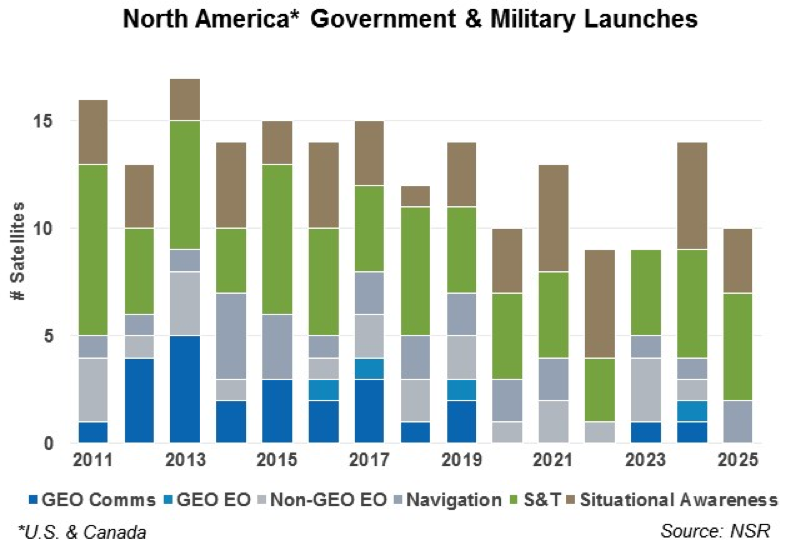Failure Looms in U.S. Government
Launch Market
Jun
15th, 2016 by
Carolyn Belle, NSR
Between congressional RD-180
debates, SpaceX’s GPS III launch award,
and millions in federal funding for new
launch technologies, the past year has
been filled with discussions of access
to space and to the U.S. Government
launch market. Current activity shows
widespread interest in addressing this
market, but do future prospects match
the interest levels of industry?
U.S. Government EELV class launch
demand has historically been addressed
by few players, and for the better part
of a decade was served by ULA alone.
The entry of SpaceX has added a
note of diversity to this
market, particularly with the recently
announced NRO contract that demonstrates
activity across the triumvirate of
government players: the NRO, Air Force,
and NASA. Yet the market
continues to grow: the Air
Force awarded development contracts
earlier this year to Orbital ATK, SpaceX,
Aerojet Rocketdyne, and ULA/Blue Origin
that will broaden the launch vehicle
landscape. By 2020, today’s
market of two players and three vehicles
could double to four players and six+
vehicles.
In what will be a challenge for
incumbent and new market entrants,
U.S. Government launch demand is
not expected to increase at a comparable
rate in the coming decade.
NSR’s recent Satellite Manufacturing and
Launch Services, 6th Edition
report found that government
launch rates will average 12 satellites
per year between 2016-2025, 20% less
than the 2011-2015 average.
While GPS III launches are scheduled to
begin in 2017 and continue throughout
this forecast period, other
constellation-based programs are
reaching the end of their deployment
cycles. MUOS, AEHF, and WGS should be
fully launched by 2019, leaving little
GEO communications launch demand until
follow-on systems begin to deploy in the
late 2020s. Increased focus on
situational awareness and space security
will boost demand slightly, but
insufficiently to fully counterbalance
the lower GEO communications launch
demand.

This narrowing launch
opportunity window showcases the fading
days of pursuing only government and
military contracts. With a
growing pool of players and lower
demand, launch service providers
will not be able to achieve minimum
annual launch cadences – 5-6
for some, up to 10 for others – with
government contracts alone. Further, the
historically high prices and revenues of
U.S. Government contracts will decline
with increasing competition and the
implementation of next generation
vehicles. The challenge then
becomes competing for sufficient
commercial contracts to complement
government business.
Yet, the net entry of three or more
vehicles to the global commercial market
in 2020 will transform an already
competitive market to be even more
competitive. EELV class launch
demand is not expected to increase
significantly in the 2020s, meaning
either fewer launches per player,
decline in price to the point of
elasticity and increasing demand, or a
market exit. Requirements for
manufacturing volumes and reliability
mean the requisite reduction in launches
per player to accommodate seven of them
is not sustainable. The
point of launch demand elasticity
remains untested, but for Beyond-LEO
markets the regulatory restrictions and
addressable market will be other key
limiting factors to demand growth.
Finally, the other launch service
providers – Arianespace, ILS, MHI –
benefit from government support through
guaranteed launch contracts,
manufacturing volume, or R&D funding and
will not be allowed to fail.
This leaves one or more U.S. launch
service providers as most likely to exit
the market, begging the
question: By funding and supporting
multiple new vehicles and launch service
providers without providing a guaranteed
market, is the U.S. Government
setting up its own industry to fail?
Bottom Line
Recent U.S. Government initiatives to
expand the monopolistic launch market to
initially two players, and potentially
up to four, will increase diversity of
launch options, decrease average
pricing, and reinforce assured access to
space. Yet the simultaneous slackening
of government and military demand will
force these launch service
providers to look to commercial
opportunities to complement
government business, driving competition
in a market that ultimately cannot
sustain all players.
While recent U.S. Government awards
present an attractive opportunity to win
funding for R&D and a piece of its still
lucrative launch market, current and new
EELV class launch providers must be
conscious of the challenges they will
face in building a sustainable business
with a commercial market component.